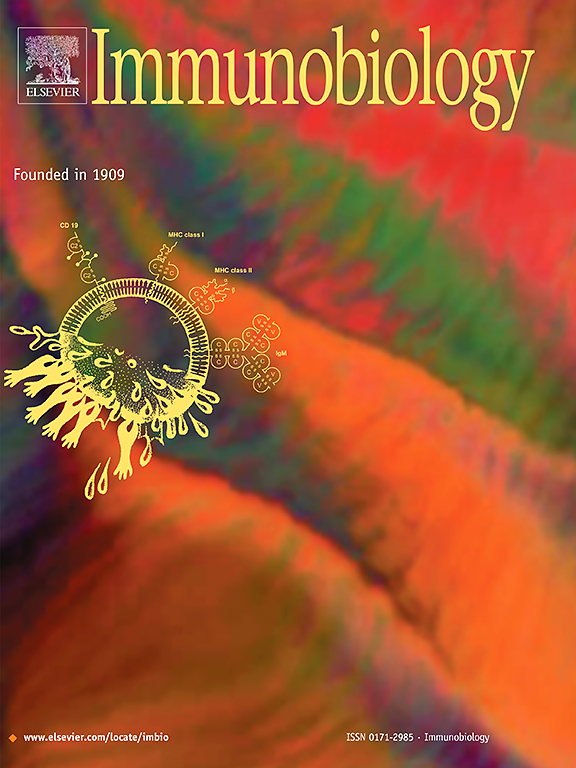非靶向代谢组学揭示肝囊包虫病患者术后代谢动态
IF 2.3
4区 医学
Q3 IMMUNOLOGY
引用次数: 0
摘要
肝囊性棘球蚴病(CE)是一种由细粒棘球绦虫幼虫期引起的慢性寄生虫病,是一种重要的全球性人畜共患病,特别是在中国西北牧区。目前的诊断和术后评估方法,包括影像学、血清学和分子技术,缺乏无创、成本效益高、诊断准确性高的血清生物标志物。目的应用非靶向代谢组学分析探讨CE患者手术前后的动态代谢变化。方法采用超高效液相色谱(UHPLC)和四极杆飞行时间高分辨率质谱法对CE患者血清代谢物进行分析。术前、术后1周、4周和12周采集样本,同时采集健康对照者的样本。进行了四项比较:术前患者与健康对照,术后1、4和12周的样本与术前样本。利用生物信息学分析鉴定差异代谢物,随后进行京都基因与基因组百科全书(KEGG)途径富集。通过识别所有比较中共享的富集途径,确定了与术后恢复相关的关键代谢途径。利用ELISA进一步验证了这些途径中的代谢物。结果术前CE患者与健康对照组之间差异代谢物数量最多。术后,代谢差异随时间增加。KEGG通路富集显示亚油酸和花生四烯酸代谢显著改变,这两者都与炎症有关。ELISA证实术前白三烯、前列腺素、血栓烷、炎症因子IL-5、IL-23水平升高,术后呈时间依赖性显著下降。结论靶向代谢组学鉴定出与花生四烯酸通路密切相关的代谢物,可作为CE诊断和术后恢复监测的潜在生物标志物。这些发现为开发肝囊性包虫病的无创诊断和预后工具提供了基础。本文章由计算机程序翻译,如有差异,请以英文原文为准。
Untargeted metabolomics reveals postoperative metabolic dynamics in hepatic cystic echinococcosis patients
Background
Hepatic cystic echinococcosis (CE) is a chronic parasitic disease caused by the larval stage of Echinococcus granulosus and remains a significant global zoonosis, particularly in pastoral regions of northwest China. Current diagnostic and postoperative evaluation methods, including imaging, serology, and molecular techniques, lack non-invasive, cost-effective serum biomarkers with high diagnostic accuracy.
Objective
This study aimed to investigate dynamic metabolic changes before and after surgery in CE patients using untargeted metabolomics analysis.
Methods
Serum metabolites from CE patients were analyzed using ultra-high performance liquid chromatography (UHPLC) and quadrupole time-of-flight high-resolution mass spectrometry. Samples were collected preoperatively and at 1, 4, and 12 weeks postoperatively, alongside samples from healthy controls. Four comparisons were made: preoperative patients vs. healthy controls, and postoperative samples at 1, 4, and 12 weeks vs. preoperative samples. Differential metabolites were identified using bioinformatics analysis, followed by Kyoto Encyclopedia of Genes and Genomes (KEGG) pathway enrichment. The key metabolic pathways associated with postoperative recovery were determined by identifying shared enriched pathways across all comparisons. Metabolites in these pathways were further validated using ELISA.
Results
The highest number of differential metabolites was observed between preoperative CE patients and healthy controls. Postoperatively, metabolic differences increased with time. KEGG pathway enrichment revealed significant alterations in linoleic acid and arachidonic acid metabolism, both of which are linked to inflammation. ELISA confirmed elevated preoperative levels of leukotrienes, prostaglandins, thromboxanes, and inflammatory cytokines IL-5 and IL-23, which significantly declined after surgery in a time-dependent manner.
Conclusions
Untargeted metabolomics identified metabolites closely associated with the arachidonic acid pathway as potential biomarkers for CE diagnosis and postoperative recovery monitoring. These findings provide a foundation for developing non-invasive diagnostic and prognostic tools for hepatic cystic echinococcosis.
求助全文
通过发布文献求助,成功后即可免费获取论文全文。
去求助
来源期刊

Immunobiology
医学-免疫学
CiteScore
5.00
自引率
3.60%
发文量
108
审稿时长
55 days
期刊介绍:
Immunobiology is a peer-reviewed journal that publishes highly innovative research approaches for a wide range of immunological subjects, including
• Innate Immunity,
• Adaptive Immunity,
• Complement Biology,
• Macrophage and Dendritic Cell Biology,
• Parasite Immunology,
• Tumour Immunology,
• Clinical Immunology,
• Immunogenetics,
• Immunotherapy and
• Immunopathology of infectious, allergic and autoimmune disease.
 求助内容:
求助内容: 应助结果提醒方式:
应助结果提醒方式:


